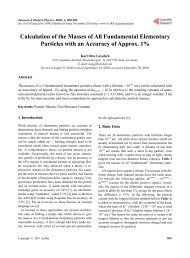Locali crysta ization an als using nd orienta molecula ation of h ar ...
Locali crysta ization an als using nd orienta molecula ation of h ar ...
Locali crysta ization an als using nd orienta molecula ation of h ar ...
You also want an ePaper? Increase the reach of your titles
YUMPU automatically turns print PDFs into web optimized ePapers that Google loves.
1<br />
2<br />
3<br />
4<br />
5<br />
6<br />
7<br />
8<br />
9<br />
10<br />
11<br />
12<br />
13<br />
14<br />
15<br />
16<br />
17<br />
18<br />
19<br />
20<br />
21<br />
22<br />
23<br />
24<br />
25<br />
26<br />
27<br />
28<br />
29<br />
30<br />
31<br />
32<br />
Acta Crystallographica Section D rese<strong>ar</strong>ch papers<br />
achieved by the choice <strong>of</strong> the cluster compou<strong>nd</strong> <strong>an</strong>d the wavelength used for the diffraction<br />
experiment.<br />
3.6. Applic<strong>ation</strong> <strong>of</strong> MR for substructure determin<strong>ation</strong> in StyA1-TaB derivative <strong>crysta</strong>ls<br />
For experimental phase determin<strong>ation</strong> <strong>of</strong> StyA1,TaB derivative <strong>crysta</strong>ls were obtained together with<br />
other single heavy atom derivatives (to be published, Table 1). However, loc<strong>ation</strong> <strong>of</strong> TaB failed with<br />
SHELXD although the data were resolved to 2.4 Å. Employing the MR-approach, a TaB-site was<br />
readily identified (Fig. 6A). Correct <strong>an</strong>d wrong solutions <strong>ar</strong>e cle<strong>ar</strong>ly discriminated by the highest<br />
score values <strong>of</strong> 0.188 <strong>an</strong>d 0.087, respectively (Table 2). Using these Ta-sites in <strong>an</strong> SAD experiment a<br />
seco<strong>nd</strong> TaB-site was located by residual/LLG-map <strong>an</strong>alysis in SHARP. Occup<strong>an</strong>cy refinement in<br />
CNS revealed that site 2 showed a much lower occup<strong>an</strong>cy (�30%) comp<strong>ar</strong>ed to site 1 (�60%).<br />
Finally, all Ta-sites together were used in <strong>an</strong> SAD experiment to obtain <strong>an</strong> interpretable electron<br />
density map after solvent flattening <strong>an</strong>d tw<strong>of</strong>old NCS-averaging (Fig. 6B).<br />
3.7. Applic<strong>ation</strong> <strong>of</strong> MR for substructure determin<strong>ation</strong> in derivative <strong>crysta</strong>ls <strong>of</strong> a fragment <strong>of</strong> the<br />
mouse ubiquitin-activating enzyme<br />
Another challenging test case for experimental phase determin<strong>ation</strong> is the X-ray structure <strong>of</strong> a<br />
fragment <strong>of</strong> the mouse ubiquitin-activating enzyme (MUAE; 1Z7L; (Szczep<strong>an</strong>owski et al., 2005)).<br />
The final structure is resolved to (2.8 Å). Derivative <strong>crysta</strong>ls contained three TaB clusters with very<br />
high average B-factors (�87 Å 2 ) <strong>an</strong>d very low occup<strong>an</strong>cies (15%, 18% <strong>an</strong>d 19%). Consequently these<br />
TaB sites appe<strong>ar</strong> as single peaks in the <strong>an</strong>omalous difference map, but their <strong>orienta</strong>tion c<strong>an</strong> still be<br />
determined by the shape <strong>of</strong> the <strong>an</strong>omalous difference map. Initial attempts to place TaB by MR with<br />
the Ta-peak data at 3.3 Å revealed only one <strong>of</strong> the two stronger sites, probably because <strong>of</strong> the weak<br />
<strong>an</strong>omalous signal beyo<strong>nd</strong> 5 Å (Szczep<strong>an</strong>owski et al., 2005). To improve the quality <strong>of</strong> the input data<br />
we combined the <strong>an</strong>omalous data <strong>of</strong> all three MAD-datasets by summ<strong>ation</strong>. In addition, <strong>an</strong> overall B-<br />
factor <strong>of</strong> 85 Å 2 was applied to the se<strong>ar</strong>ch model <strong>an</strong>d the packing function was enabled. Running a<br />
sequential MR-se<strong>ar</strong>ch in MOLREP with these settings, the correct three solutions were identified as<br />
i<strong>nd</strong>icated by <strong>an</strong> increasing score value, which otherwise stagnated at the score value <strong>of</strong> site 1.<br />
Interestingly, two <strong>of</strong> these solutions fitted well to the shape <strong>of</strong> the <strong>an</strong>omalous difference map (Fig. 7).<br />
One cluster was placed in r<strong>an</strong>dom <strong>orienta</strong>tion. Nonetheless, good phases were calculated in <strong>an</strong> SAD<br />
experiment <strong>an</strong>d <strong>an</strong> interpretable electron density map was obtained after phase extension to 2.8 Å<br />
(high energy remote dataset), solvent flattening <strong>an</strong>d NCS-averaging (Fig. 7).<br />
3.8. Comp<strong>ar</strong>ison <strong>of</strong> the MR-approach to other methods for substructure determin<strong>ation</strong> <strong>of</strong> HA-<br />
clusters.<br />
12




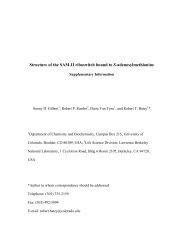

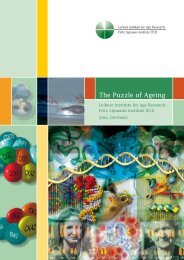

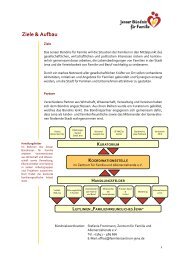



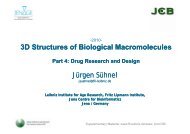
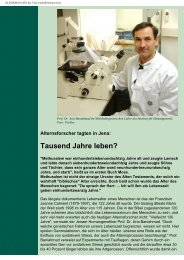

![Programm [pdf]](https://img.yumpu.com/20944039/1/184x260/programm-pdf.jpg?quality=85)
